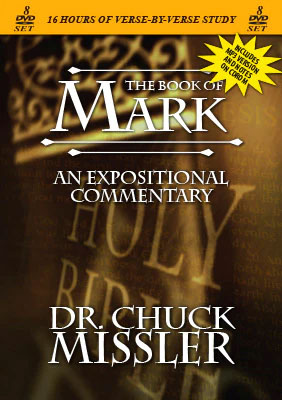“Finishing Well” is the name of the game. Here was a rich, young ruler—a 1st century “yuppie” if you will—who, although getting off to a rather problematic beginning, finished well, indeed.
John Mark was the son of a wealthy woman named Mary, probably a widow, whose home was large enough to serve as a meeting place for many of the early disciples after the Pentecostal outpouring.1
The Rich Young Ruler Who Fled Naked?
A rich young ruler questioned Christ about what he needed to do to inherit eternal life.2 Mark’s Gospel includes a detail that Matthew and Luke failed to mention: “And Jesus looking upon him loved him...”3 This hints at the possibility that young John Mark himself may have been that rich young man.
An early church tradition also suggests that it was this same Mark who was “the certain young man” who followed Christ right up to His entry into the house of the high priest and then, when the guards tried to lay hold of him, left the linen cloth that he was clothed with in their hands and fled naked!4 (Mark was the only one who included this incident.)
Mark accompanied Paul and Barnabas to Cyprus, but later returned to Jerusalem, which deeply disappointed Paul.5 Having felt abandoned and betrayed, Paul refused to take him on the second journey, and thus began a bitter quarrel between Paul and Barnabas (to whom Mark was related).6 Silas then accompanied Paul in retracing his steps, and Mark accompanied Barnabas to Cyprus.
Fortunately, Paul and Mark later reconciled when Paul was in prison in Rome. Mark served as his aide and then as a delegate on an important mission to Asia Minor.7 Later Paul asked Timothy to bring Mark back with him to Rome because he was useful in service.8 When Peter was writing 1st Peter, he affectionately called Mark “his son.”9 It may well have been Peter that originally led him to Christ. It was Mark’s intimacy with Peter that resulted in his intimate portrait of Christ we call the Gospel of Mark.
A Gospel of Action
Mark’s style is that of a shooting script, as for a movie or a teleplay. It moves rapidly through a series of visual images, emphasizing action. Mark continually uses a word εὐθέως, eutheos, which is translated “immediately,” “straightway,” “forthwith,” “anon,” etc. (It appears over 40 times—about equal to the rest of the New Testament put together: only seven times in Matthew; only once in Luke.)
Mark uses the “historical present tense” 150 times. Jesus comes, Jesus says, Jesus heals—all in the present tense.
There are more miracles recorded in Mark than in the other Gospels, despite its being shorter. (Matthew’s Gospel seems longer only because he includes the discourses—probably verbatim, having the skill to take them down in shorthand required of a customs official. Removing the discourses, it is shorter than Mark’s.)
The action moves right along: It takes only 20 short verses in Chapter 1 to describe the ministry of John the Baptist, Jesus’ baptism, His temptation in the wilderness, and the call of the disciples.
The Gospel for Romans
Mark’s purpose was to write down the Gospel, as Peter had presented it, to Romans (so say the Fathers, at least, and internal evidence supports them). That the Gospel was for Gentiles can be seen:
- From the translation of the Aramaic expressions as Boanerges,10 Talitha cumi,11 Corban,12 Bartimaeus,13 Abba,14 and Golgotha;15
- In the explanation of Jewish customs;16
- From the fact that the Law is not mentioned and the Old Testament is only once quoted in Mark’s own narrative;
- The Gentile sections, especially in Mark Chapters 6 through 8.
That it was for Romans specifically is seen in:
- The explanation of a Greek term by a Latin in Mark 12:42;
- The preponderance of works of power, the emphasis on authority,17 patience and heroic endurance;18
- Highlighting the forbidding of a practice that was not Jewish but Roman.19
Those who believe it was written at Rome find further hints in the mention of Rufus20 and the resemblance between Mark 7:1-23 and Romans 14. (However, the common presumption that “Babylon” is Peter’s code name for Rome21 is disputed by some authorities. Peter was the apostle to the Jews, and Babylon was a major Jewish center—the Babylonian Talmud later emerged from there.)
The Roman centurion’s remark, “Truly this man was the Son of God,”22 is also the style of the author, and bears the same relation to Mark’s purpose as does John 20:31 to John’s.
Servant Emphasis
But one cannot escape the feeling that we have in this Gospel the anti-type of the Servant of YHWH. It is not strange that this “servant” emphasis—this remarkable blend of strength and submission, achieving victory through apparent defeat—should appeal to Peter. He was himself an ardent, wholehearted man who knew both defeat and victory. Moreover, he himself had hired servants,23 and now for years had been a servant of Christ.24 That this did appeal to him and became familiar to the early Christians can be seen from Acts 3:13 and 4:30. (In Peter’s 1st epistle he has 17 references to Isaiah, nine of which belong to the second part, the Suffering Servant.)
Temperamentally, Mark seems to have been like Peter. And his experience in a wealthy home where servants were kept,25 and as himself a huperetes (“under rower”) of apostles in Christian service, fitted him both to appreciate and record the character and doings of the perfect servant—the Servant of YHWH. For Roman Christians, that heroic figure would have a peculiar fascination.
Mark’s focus is servanthood. The key verse is:
For even the Son of man came not to be ministered unto, but to minister, and to give his life a ransom for many.
Mark 10:45
We are introduced to the God who, in the words of Paul to the Philippians:
...being in the form of God, thought it not something to be grasped to be equal with God: But made himself of no reputation, and took upon him the form of a servant, and was made in the likeness of men:
Philippians 2:6-7
Notes:
- Acts 12:1-19.
Mark 10:17-22.
Mark 10:21.
Mark 14:51-52.
Acts 12:25; 13:13; 15:37-39.
Probably a cousin, not “nephew” (as in KJV); the word anepsios (Colossians 4:10), being used in Numbers 36:11 for “father’s brothers’ sons.”
Cf. Philemon 24 and Colossians 4:10.
2 Timothy 4:11.
1 Peter 5:13.
Mark 3:17.
Mark 5:41.
Mark 7:11.
Mark 10:46.
Mark 14:36.
Mark 15:22.
Mark 14:12 and 15:42.
Mark 2:10.
Mark 10:17 ff.
Mark 10:12.
Mark 15:21; cf. Romans 16:13.
1 Peter 5:13.
Mark 15:39.
Mark 1:20.
Cf. Acts 4:29.
Acts 12:13.







